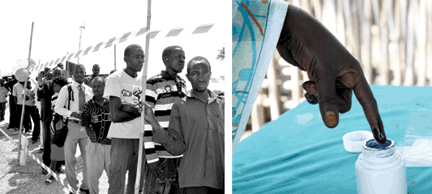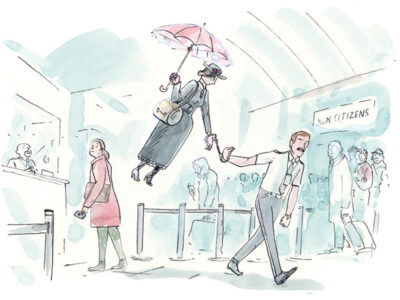
On the ground in Sudan, the week it was split in two.
By Jim Parys
It was December 23, 2010. I and my colleagues in Sudan were 17 days away from one of the most historic democratic exercises the United States has ever supported in Africa—a referendum that would result in the partition of Sudan, the continent’s largest country.
In Khartoum and Juba, we at the US Agency for International Development (USAID) Mission in Sudan anxiously awaited delivery of voting materials that would enable nearly 4 million southern Sudanese to choose their future—opting either to remain part of Sudan, or to secede and form an independent nation. The 2005 peace agreement that ended Sudan’s civil war—Africa’s longest and one of its deadliest—had promised southern Sudanese this referendum, and they were determined to make that choice as promised, without delay.
Africa’s borders had been unchanged since 1993, when Eritrea won its independence from Ethiopia after a bitter civil war. Never before had there been a change in the post-colonial borders on the continent. Sudan’s two civil wars had killed some 2.5 million people between 1956 and 2005. A successful completion of the peace agreement was the best chance that the killing would stop for good.
Up to this time, our mission had also been split between Khartoum, Sudan’s desert-dusted capital, and Juba, a city in the South surrounded by a broad green savanna. We had been staffed with Sudanese from both regions and we could sense an anxiety from both sides. The southerners were proud and not reticent to show they supported separation. The northerners showed some disappointment with what seemed to be that inevitable conclusion. We Americans were settled that this would lead to a final end to years of full-scale fighting.
The November 2010 registration of nearly all of southern Sudan’s 4 million eligible voters had gone smoothly, but it was extremely challenging reaching that point. Registration took place months later than the referendum law required, and only about one-fourth of southern Sudanese adults can read and write—mainly because of the many years of conflict they endured, frequently displaced from their homes in one of the world’s least developed countries. We met with Sudanese officials from the National Election Commission almost daily.
Most of southern Sudan has no paved roads and no electricity, and most southern Sudanese had never cast any ballot before 2010, when nationwide elections had been held.
The referendum ballots were carefully designed so that illiterate voters could understand their choices of unity (illustrated by two clasped hands) or secession (indicated by an open palm). The terms “unity” and “secession” were also written in both English and Arabic. Voters made their selection with an ink thumbprint next to their choice, then dipped their forefinger in long-lasting ink to indicate they had voted and prevent any attempt to vote again.
As ballots and polling kits manufactured outside Sudan arrived, it was still unclear whether the materials could be distributed throughout the country in time for voting to begin on January 9. It was also uncertain whether the vote would be peaceful. The referendum was a daunting prospect for Sudan; approximately one-third of its land and population, and 75 percent of its oil revenue, were at stake if southern Sudan seceded.
Tensions rose in early January as the referendum voting period approached. By then, more than 115,000 Sudanese of southern origin had returned to the south in just over two months, traveling from Khartoum and other areas of the north where they had been living, many of them for decades, as a result of the years of conflict. They returned not only to vote in the referendum but also to resettle in the south. There was uncertainty about what status southerners in the north would have if the referendum outcome was secession.
On January 4, five days before voting was to begin, Sudanese President Omar al-Bashir made a rare visit to Juba, then the capital of the autonomous region of southern Sudan. In what former US President Jimmy Carter later called “a turning point,” al-Bashir met with southern leaders and pledged to “respect the choice of the southern citizens.”
Even though we had seemed so close to failure before, I was now persuaded that my request for this assignment from USAID in 2009 had been the right move. Previously I had done stints supporting work in Yemen, Armenia, and Russia. Though we had made inroads in all our programs in these countries, nowhere else in the world was USAID on the cusp of making such a significant and unique contribution to peace and future development.
As voting began on January 9, long lines formed at polling locations across southern Sudan, and people waited patiently in the hot sun for hours to vote, some sitting on rocks as they waited in line because there were no chairs. As we travelled from polling site to polling site, we observed voters swimming across a tributary of the Nile in order to vote after a local ferry had broken down.
When the seven days of voting closed on January 15, poll workers followed the procedures for which they had been trained—closing the polling station, securing the location for counting, then starting the vote count. This took place across Sudan, mostly in areas where there was no electricity.
The workers unpacked the materials provided by USAID in polling kits that were delivered across the country—containing battery-operated lanterns so they could work in the dark, calculators, pens, and rubber bands to bind hand-counted ballots in bunches of 25.
Our staff observed the vote and count at several locations, including a two-room schoolhouse in Lologo, a neighborhood in Juba. Five poll workers stood in one room counting the votes while four USAID staff members and five Sudanese from nonpartisan organizations observed the count to make sure it was conducted fairly. A poll worker opened ballots one by one, and held them them up for the observers to see, calling out “Secession” or “Unity” or “spoiled ballot” or “unmarked.”
It took a few days to gather votes from across southern Sudan at the USAID-funded data center in Juba where the final results were tabulated and certified. The excitement of my south Sudanese colleagues was beyond palpable. They greeted all of us with what became the common call: “South Sudan oye!”
In the end, turnout exceeded 97.5 percent, and nearly 99 percent of those who voted chose secession. The southern Sudanese people were on the path to independent nationhood after decades of war, deprivation, and displacement. On July 9, South Sudan officially became the world’s newest nation, and just five days later, became the 193rd UN member state.
Despite this success, no one can claim that all of Sudan’s problems are solved. The real work of creating a new country has just begun, and with such low literacy and overall lack of development, South Sudan has a long way to go to be a strong and stable nation. And for the remainder of what is now Sudan, the challenges are no less great after losing most of what it has survived on over the past 20 years: oil and other natural resources.
It’s not surprising too that in the aftermath, both South Sudan and Sudan have not had a easy time ending all their disputes. Fighting in border states between groups that have affinities to one side or the other continues. However, the peaceful conclusion of the referendum stands as a major accomplishment of the peace agreement and of the international community’s efforts to bring peace and democratic transformation to the people of both Sudans.
Jim Parys G’90 is the head of the Program & Project Development Office at USAID’s Mission to Sudan.




